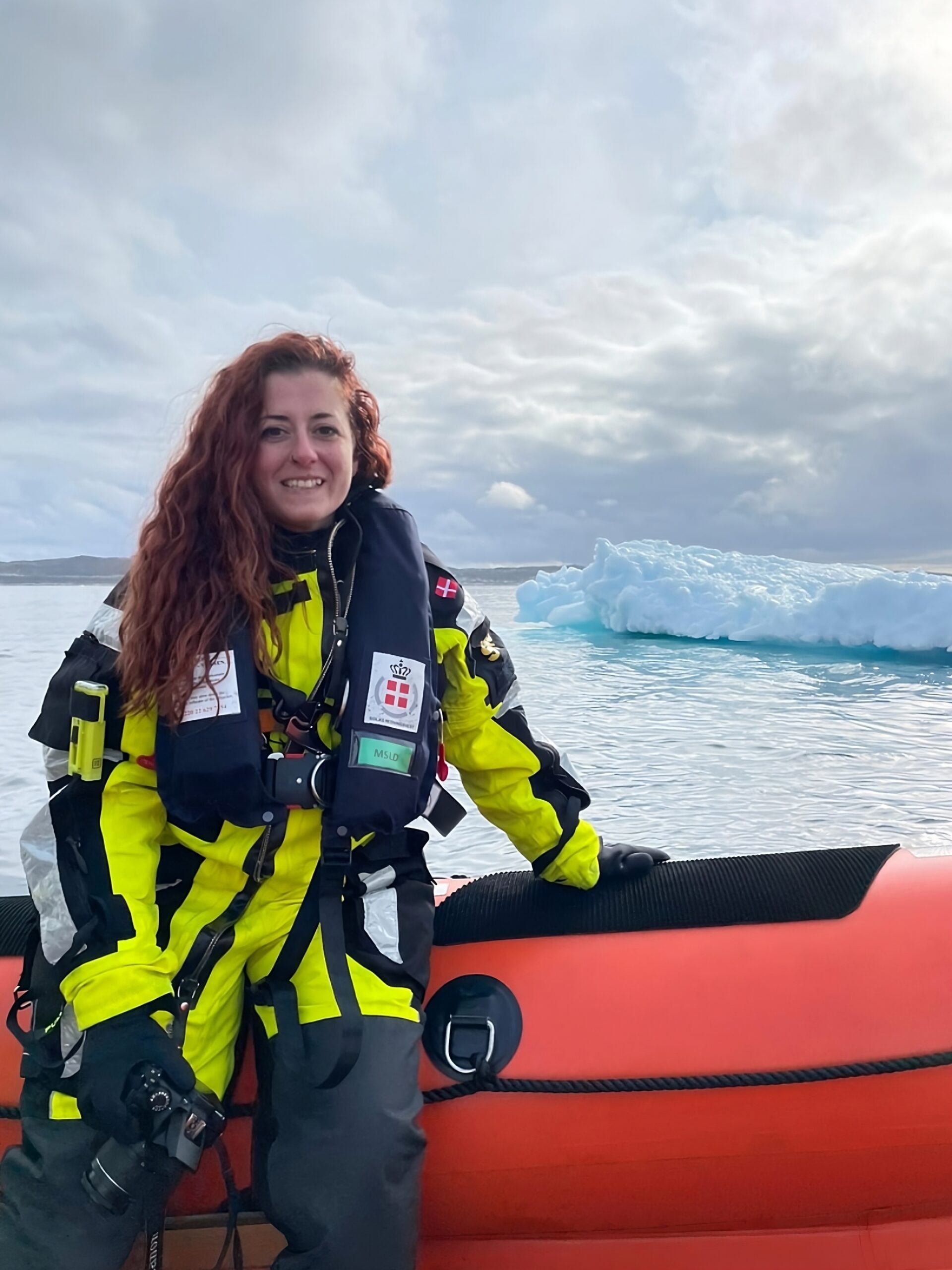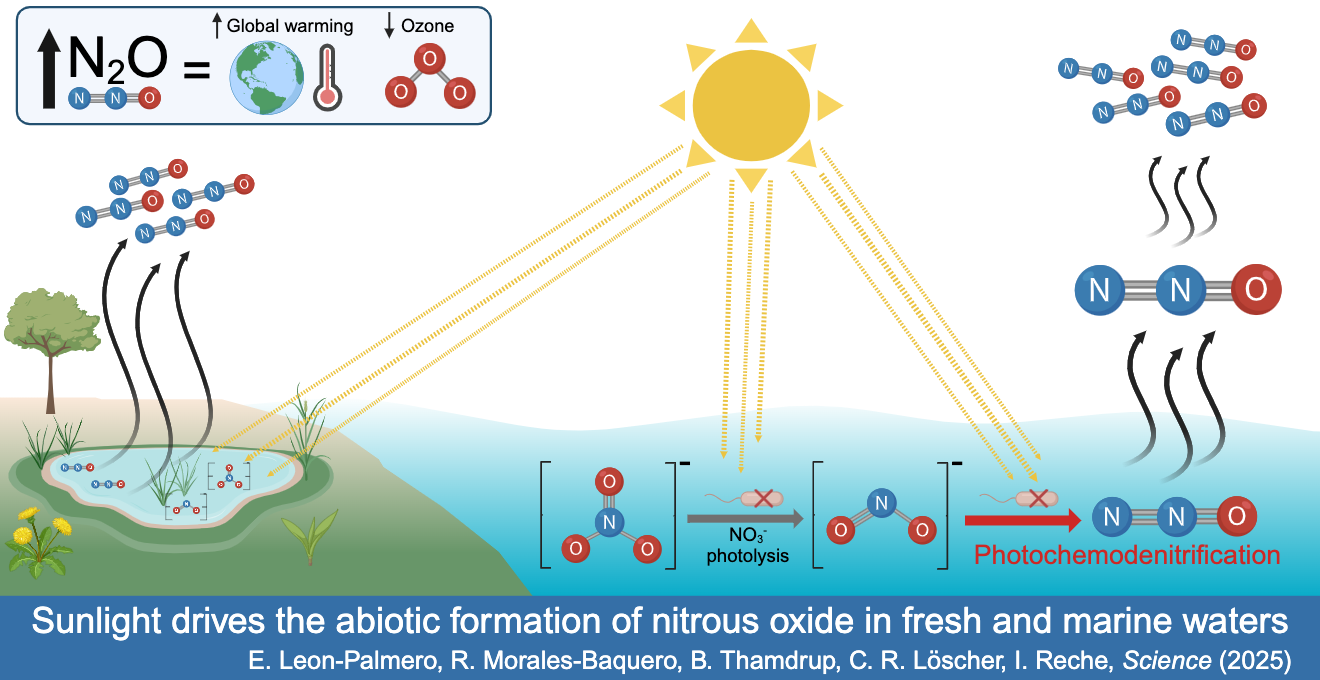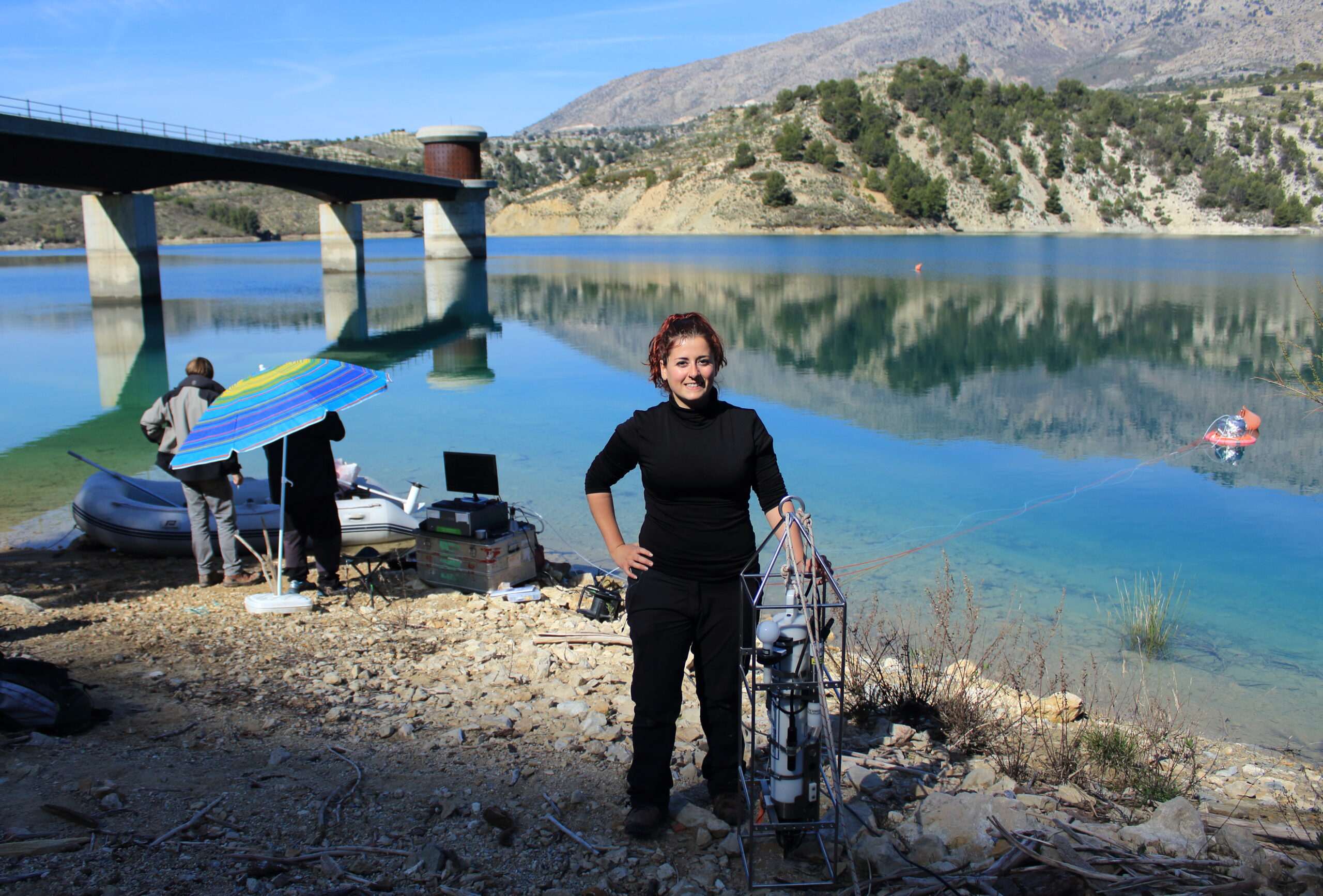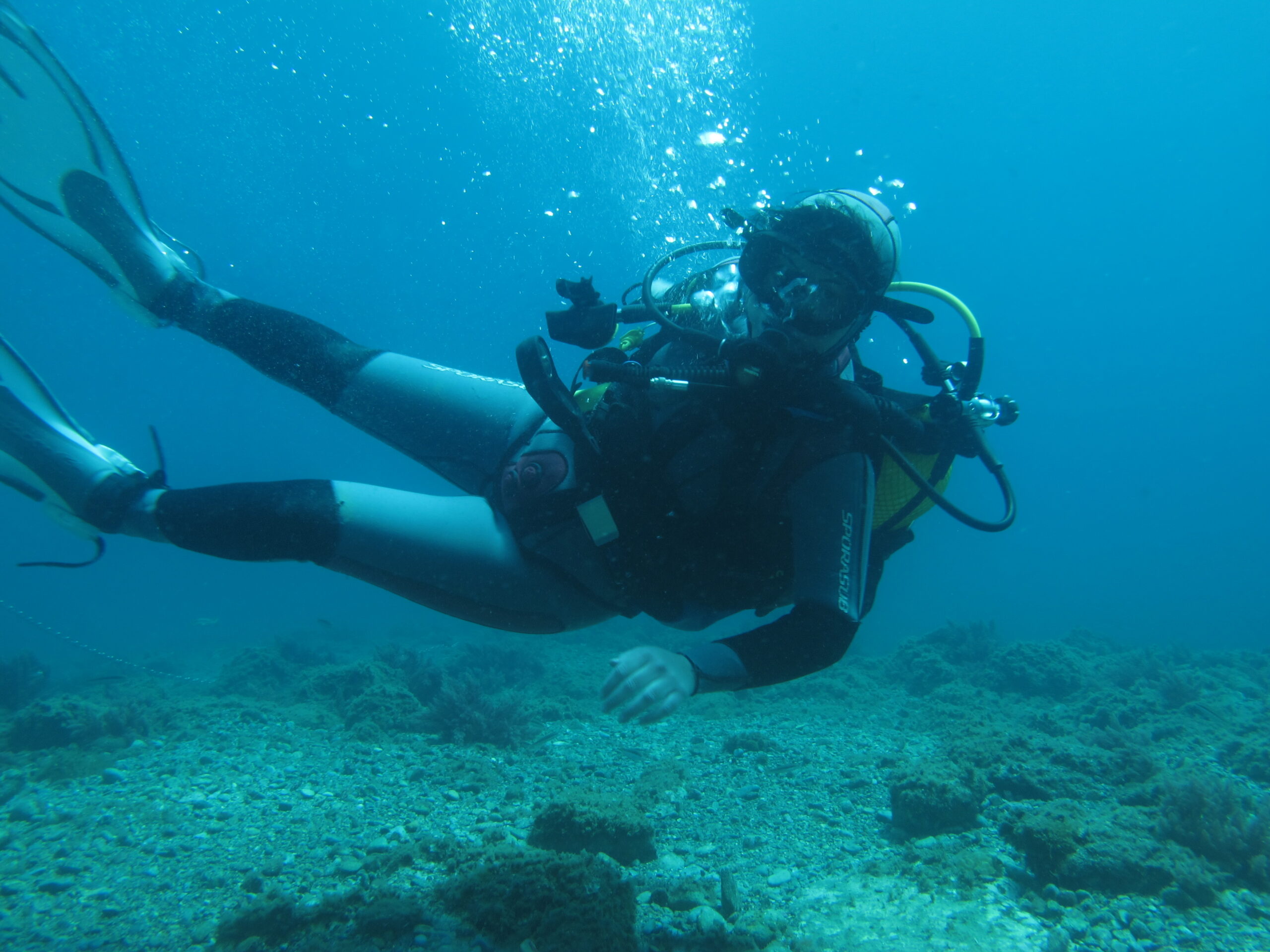Scientific Interests
| Marie Sklodowska-Curie postdoctoral fellow | The Ward Lab at Princeton University |
As a biogeochemist and microbial ecologist, Elizabeth is broadly interested in how microorganisms and abiotic reactions influence global biogeochemical cycles across scales in aquatic ecosystems, particularly in their roles in the production and consumption of greenhouse gases such as carbon dioxide (CO2), methane (CH4) and, especially, nitrous oxide (N2O).
Her current research focuses on the recently discovered photochemical production of N2O in surface waters.


Sunlight drives the abiotic formation of nitrous oxide in fresh and marine waters
Nitrous oxide (N2O) is a potent greenhouse gas and the main stratospheric ozone-depleting agent, yet its sources are not well resolved. In this work, we experimentally show a N2O production pathway not previously considered in greenhouse gas budgets, which we name photochemodenitrification. Sunlight induces substantial and consistent N2O production under oxic abiotic conditions in fresh and marine waters. We measured photochemical N2O production rates using isotope tracers and determined that nitrite is the main substrate and that nitrate can also contribute after being photoreduced to nitrite. Additionally, this N2O production was strongly correlated to the radiation dose. Photochemodenitrification exceeded biological N2O production in surface waters. Although previously overlooked, this process may contribute considerably to global N2O emissions through its occurrence in fresh and marine surface waters. | Science, 2025
Graphical abstract created in BioRender. Leon Palmero, E. (2025) https://BioRender.com/w82u461, CC-BY 4.0.
Animation created in BioRender. Leon Palmero, E. (2025) https://BioRender.com/i13e835, CC-BY 4.0. Voice by elevenlabs.io

Princeton University
Currently, Elizabeth is a Marie Skłodowska-Curie postdoctoral fellow working with Prof. Bess B. Ward in the Department of Geosciences at Princeton University, where she investigates the production of N2O in the surface ocean.
Previously, she worked as a postdoctoral researcher with Prof. Carolin Löscher at Nordcee in the University of Southern Denmark, where she investigated nitrous oxide sinks and sources in the surface waters of the coast of west Greenland and in the Baltic Sea.

PhD Work
She pursued a Ph.D. at the University of Granada (UGR) under the guidance of Profs. Isabel Reche and Rafael Morales-Baquero. She defended her thesis, titled “Greenhouse Gases in Reservoirs: From Watersheds to Functional Genes” in 2021, and received a summa cum laude qualification.
Her thesis was later awarded The Best PhD Thesis in Limnology 2021 by the Iberian Society for Limnology (AIL) and subsequently received Third Prize for the Best European PhD Thesis in Freshwater Sciences for 2021-2022 by the European Federation for Freshwater Sciences (EFFS).

Previous work
She earned a BSc in Biology from the UGR in 2014, where she was honored with the bachelor’s degree Extraordinary Award by the UGR, and the National Award for Excellence in Academic Performance by the Spanish Ministry of Science, Innovation, and Universities.
She also obtained an MSc in Microbiology from the same university in 2015.
Current Research
Production of N2O in the surface ocean
Nitrous oxide (N2O) is a potent greenhouse gas and the main stratospheric ozone depleting agent, yet its sources are not well resolved.
Elizabeth investigates the sources and sinks for nitrous oxide in surface waters, with especial focus to the photochemical processes.
Her recent research has led her to participate in field campaigns to Greenland (2022), the Baltic Sea (2022), the South Pacific Ocean (ETSP, 2023), and soon, the North Atlantic Ocean (July 2025).
Keywords: Nitrous oxide, denitrification, biogeochemistry, microbiology
Previous work (PhD)
Greenhouse gases (CO2, CH4, and N2O) in freshwater reservoirs
Reservoirs are significant sources of the greenhouse gases (GHGs), as carbon dioxide (CO2), methane (CH4), and nitrous oxide (N2O). However, our knowledge on the GHG fluxes from reservoirs is still very limited at latitudinal and temporal scales, and there are many uncertainties on the GHG production and environmental drivers. During her PhD dissertation, Dr. Leon-Palmero quantified the fluxes of CO2, CH4, and N2O in twelve Mediterranean reservoirs, and examined the concentrations, and productions in the water column, with a particular emphasis on the CH4 and N2O, and their environmental and microbial drivers.
The fluxes of CO2, CH4, and N2O were measured in twelve reservoirs during the summer stratification and the winter mixing. GHGs fluxes presented a high inter-system and inter-season variability ranging more than three orders of magnitude. Some reservoirs were sinks, and other sources for CO2 and N2O fluxes, but all reservoirs were CH4 sources.
Publications
Greenhouse gas fluxes from reservoirs determined by watershed lithology, morphometry, and anthropogenic pressure
The fluxes of CO2, CH4, and N2O were measured in twelve reservoirs during the summer stratification and the winter mixing. GHGs fluxes presented a high inter-system and inter-season variability ranging more than three orders of magnitude.
https://doi.org/10.1088/1748-9326/ab7467
Consistent higher emissions of carbon dioxide, nitrous oxide, and methane during the daytime in reservoirs
We explored the daily patterns in the fluxes of CO2, N2O, and the diffusive and the ebullitive components of CH4 in two eutrophic reservoirs. GHG fluxes exhibit a significant daily variability with higher emissions during the daytime than during the nighttime and similar daily patterns for CO2, N2O, and diffusive CH4 fluxes.
https://doi.org/10.1101/2023.10.24.563772
Dissolved CH4 coupled to photosynthetic picoeukaryotes in oxic waters and to cumulative chlorophyll a in anoxic waters of reservoirs
Along the water column of these twelve reservoirs, dissolved CH4 varied up to 4 orders of magnitude (0.02 – 213.64 μmol L-1), and both oxic and anoxic depths were consistently supersaturated. CH4 concentration was related to phytoplankton biomass and primary production.
https://doi.org/10.5194/bg-17-3223-2020
P inputs determine denitrifier abundance explaining dissolved nitrous oxide in reservoirs
Reservoirs are important sites for nitrogen processing, especially those located in agricultural and urban watersheds. Nitrogen inputs promote N2O production and emission, but the microbial pathways controlling N2O have been seldom studied in reservoir water columns. We determined N2O concentration in the water column of 12 reservoirs during the summer stratification and winter mixing.
https://doi.org/10.1002/lno.12381
Production of nitrous oxide from ammonium and nitrate in the water column of two reservoirs (in prep.).
Reservoirs are important sites for nitrogen cycling and a significant global source of the potent greenhouse gas nitrous oxide (N2O) to the atmosphere. They receive nitrogen inputs from agriculture and urban sources, boosting the production of N2O by nitrification and denitrification. However, previous studies on N2O production in inland waters have mainly focused on rivers or lake sediments, neglecting the water column of lentic systems.
Understanding the fluxes of greenhouse gases in reservoirs under the inspiration of Margalef
Reservoirs are significant sources of greenhouse gases, such as carbon dioxide (CO2), methane (CH4) and nitrous oxide (N2O), to the atmosphere. These systems receive and metabolize a larger amount of organic and inorganic carbon and nitrogen from their watersheds than lakes, resulting in the production of CO2, CH4 and N2O. Despite their global relevance, there are still important uncertainties regarding the magnitude, variability and drivers of their emissions that undermine global estimates.
https://doi.org/10.23818/limn.42.22
Awards and honors
Elizabeth Leon-Palmero – PhD

Best PhD Thesis in Limnology award
Iberian Association of
Limnology (AIL)
Feb 2022

Contribution to Diversity in Academia award
As member of the Gender & Science AIL group
Spanish Society for Terrestrial Ecology (AEET)
Oct 2021

National Award for Excellence in Academic Performance
Spanish Ministry of Science, Innovation and Universities
Jul 2018
Gallery
Greenland, 2022
Greenland, 2022
ETSP, 2023
ETSP, 2023

Contact
Elizabeth Leon-Palmero
+1 (609) 258-4674
159 Guyot Hall,
Princeton, NJ, 08544, USA

This site has received funding from the European Union’s Horizon Europe research and innovation program under the Marie Skłodowska-Curie postdoctoral fellowship
HORIZON-MSCA-2021-PF-01, grant agreement No 101066750.
